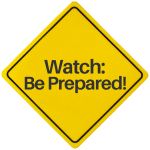A tsunami is a massive volume of moving seawater. The most frequent cause of a tsunami is the buckling of the seafloor caused by an underwater earthquake. According to NOAA, since the beginning of the 19th century, tsunamis have caused more than 700 deaths and approximately $2 billion in damage to U.S. coastal states and territories.
See how to determine your risk, prepare your family, learn about your building code, and identify ways to strengthen your home against tsunamis.
Learn the signs of a tsunami to determine when one might hit. Recent earthquakes and loud roars from the ocean may indicate that a tsunami is imminent.
If you are under a tsunami warning, get to high ground as far inland as possible. Create a plan that keeps you, your family, and your home safe.
If a tsunami watch has been issued, monitor your NOAA Weather Radio, smartphone apps, and local news for further instructions.
Evacuate immediately if you are told to do so. Evacuation routes often are marked by a wave with an arrow in the direction of higher ground.
If you evacuated, do not attempt to re-enter the area until authorities say it is safe.
Take photos of property damage and file a claim with your insurance company.
Plan to repair and rebuild resiliently to prevent damage from future tsunamis.
Please enter a more specific address.

A Tsunami Watch means a distant earthquake has occurred, and a tsunami is possible.
Stay tuned for more information. Be prepared to take action if necessary.

A Tsunami Warning means dangerous coastal flooding and powerful currents are possible and may continue for several hours or days after initial arrival. Follow instructions from local officials. Evacuation is recommended. Move to high ground or inland (away from the water).
The Federal Alliance for Safe Homes (FLASH) — a 501(c)(3) nonprofit organization — is the leading consumer advocate for strengthening homes and safeguarding families from natural and manmade disasters.
The Playbook provides proven strategies for all leaders who wish to drive resilience.
This annual conference brings together the nation’s leading voices in disaster safety.
Inspect2Protect will help you understand the building code where you live.
A tsunami is a series of destructive ocean waves caused by various events that disturb the ocean’s surface. The most common cause of a tsunami is an underwater earthquake, but other events, such as volcanic eruptions, landslides, or meteorite impacts, can also trigger a tsunami.
When an underwater earthquake occurs, the seismic waves it generates can travel through the water and create large, powerful waves that spread out in all directions from the epicenter. These waves can move at great speeds, sometimes reaching up to 500 miles per hour, and can travel thousands of miles before reaching the coastline.
When the tsunami waves reach shallow water near the coast, they slow down and begin to increase in height as the water is forced upward. This can cause the tsunami waves to become very large, powerful, and life-threatening. Tsunamis are deadly and cause significant damage to buildings, boats, and other structures near the coast.
Not all earthquakes or underwater disturbances result in tsunamis, and not all tsunamis are equally destructive. The intensity and impact of a tsunami depend on the magnitude of the initial disturbance, the depth and proximity of the ocean floor to the coast, and the geography of the coastline itself.
The duration of a tsunami depends on several factors, including the size and intensity of the initial disturbance that caused it and the distance the waves have to travel to reach the coastline. Generally, a tsunami can last from a few minutes to several hours, with the most powerful waves arriving first and gradually decreasing in intensity over time.
The initial waves of a tsunami are usually the largest and can cause the most damage, but subsequent waves can also be dangerous and cause additional destruction. Tsunamis can also create strong currents that can persist for several hours or even days after the initial wave has passed.
It’s important to note that just because the initial waves have passed, it does not necessarily mean that the danger has passed. Tsunamis can cause significant damage to the coastline and infrastructure, and the aftermath of a tsunami can also be dangerous due to flooding, landslides, and other secondary effects.
It’s crucial to follow any evacuation orders or other instructions from local authorities in the aftermath of a tsunami.